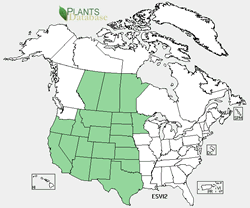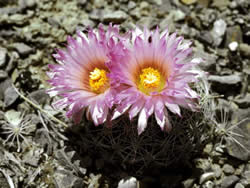Plant of the Week
 Escobaria vivipara range map. USDA PLANTS Database.
Escobaria vivipara range map. USDA PLANTS Database.
 Escobaria vivipara var. deserti, with honey-coloured flowers. Photo by Cheryl Beyer, Modoc National Forest Botanist.
Escobaria vivipara var. deserti, with honey-coloured flowers. Photo by Cheryl Beyer, Modoc National Forest Botanist.
 Escobaria vivipara var. rosea. Photo by Margaret Williams, Nevada Native Plant Society.
Escobaria vivipara var. rosea. Photo by Margaret Williams, Nevada Native Plant Society.
Spinystar (Escobaria vivipara (Nutt.) Buxbaum)
By Forest Jay Gauna
Spinystar is an apt name for this plant of the Cactaceae. The flowers are like bright pink stars atop very spiny little cacti. Another common name for this genus is “beehive cactus,” relating to the short, cylindrical stems – imagine a group of whitish tennis balls with spines. The generic name honours two Mexican botanists named Escobar, and the specific regards the fact that these little cacti bud at the base, creating a little colony of cacti. This genus had previously been part of Mammillaria, a more commonly seen plant, and has been known by the generic name Coryphantha. In Spanish, this life form is called a biznaga. The tepals are brightly coloured, and the flower looks like a ‘typical’ cactus flower, if that can be said without demeaning the beauty of nearly all of them.
This species contains several different varieties, each of which is governmentally protected as a rare plant. The variety deserti is not that common. It is fortunate to be walking through the Mojave Desert, below the majestic limestone cliffs that make up the northern part of the Spring Mountains, and almost step on the spiny ball that is the stem of this diminutive cactus, with its shy, honey-colored flowers. There is also the variety rosea, which is known from only 20 occurrences in California.
Spinystar has other ethnobotanical uses besides being pilfered from natural settings by horticultural thieves intent upon imprisoning them in their own gardens or selling this wonderful and fragile piece of the natural patrimony of the American people. Native Americans ate the tunas (fruit), and the seeds were used in eye medicine.

